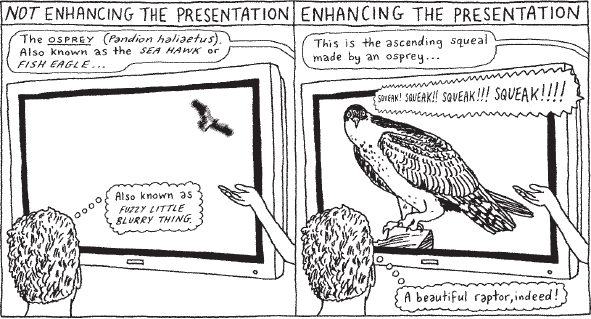Audio and Video
Printed Page 416
In many speech situations, it can be particularly useful to demonstrate an action that cannot easily be described in words or presented in a still image. In such cases, you may wish to incorporate audio selections or video clips into your presentation to vividly explain, demonstrate, or illustrate a key point. We discuss several means of sharing audio and video, as well as practical considerations for doing so, in the section on technology. But first, let’s consider the circumstances in which this type of content is most useful.
Audio. Presenting sound recordings or effects can greatly enhance a presentation if used well. In a speech about a particular musician or composer, for example, it would make sense to play a recording of his or her work for the audience. Audio can also make abstract concepts easier to understand. For example, Monica prepared a speech about the effects of loud music on hearing. Because “loud” is a relative term, Monica decided to play audio recordings of different sounds at different volumes (the engine of a compact car, a radio turned up all the way, a jet engine during takeoff). Though Monica couldn’t subject her audience to a roar as loud as a real jet engine, she arranged the relative loudness of the sounds to demonstrate noise levels by decibel and to help her audience understand the nature of sound and how it is measured.
Video. A video is useful to your presentation whenever a demonstration of the subject in action or motion would enhance the audience’s understanding more than a simple photographic representation or verbal description would. For example, a photograph depicting alpine ski racer and Olympic gold medalist Lindsey Vonn might be useful for identifying her as a world-class athlete and celebrity, but a video showing her prowess during a race would be more useful if the speech focused on racing techniques.
In the same vein, video may be a better choice for your presentation aid if a moving image can better capture the scene or setting. For example, a photograph of a redwood tree on fire might be useful in a speech about forest fires, but a digital video of a burning tree would be a better choice to demonstrate how quickly a fire can spread.
Not all video clips are useful. Video works best when it is clear, compelling, and easy to see. For example, Meg is a bird watcher, and she wants to give a speech about a particular type of seabird that nests near her home. Showing a grainy, hand-shot video clip of the fast-moving bird in flight would probably not add much to her presentation, since it would not provide a clear image of the bird or a real sense of how it moves. However, a color illustration or photo of the bird, along with an audio clip of its call, would greatly enhance her presentation.
